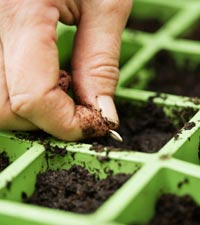By Clea Danaan
65 million Americans garden, which adds up to a lot of money spent at
garden centers each year. You can join the growing
movement of home gardening without spending a lot of your own money by
using the following tips:
- Grow from seed. A lot of vegetables and flowers
are easy to grow from seed without any special equipment. Buy organic
seed from a good source like Seeds of Change or Botanical Interests, participate in seed
trades, or bum a few off a gardener friend. Germinate the seed by
putting it between damp paper towels placed in a plastic bag in a warm
spot like the top of the hot water heater. When the little root has
popped out, carefully plant the seed in potting soil (compost mixed with peat moss
works well) in a clean, used yogurt tub that has holes poked in the bottom. Keep them moist but not soggy.
Place them in a sunny window, or put them outside during the day and
bring them in at night till night temperatures get warm enough (about 40
degrees for warm season plants; 50 degrees average for tomatoes and
peppers) to plant outside in larger pots or a bed. I put my yogurt
containers on a tray for easy transport in and out of the house, and I
cover the trays with bird netting to discourage squirrels from digging
in the dirt.
- Compost. This reduces waste, improves your garden
soil, and saves money. Purchased compost is expensive and may not be
weed free. A great way to get materials for your compost is to collect
grass clippings, dropped fruit, and raked leaves from your neighbors. Last year we got bushels of wormy apples from a neighbor, and we have fabulous compost this spring.
- Propagate from other plants. Buy some rooting
hormone, which is about $5 for a nice sized bottle. To make more
perennials, ground cover, or shrubs from ones you already have and like,
or from ones your friends and neighbors have grown, cut a bit of a
branch off and dip it into the rooting hormone. Push this branch into
potting soil, water, and cover with a plastic bag till you see new
growth. Then plant in the ground in a hole amended with compost. Many
perennials (flowers that come back year after year) can also be divided,
which involved digging them up, breaking them into smaller clumps, and
replanting. Water well and feed with compost for best results.
- Take advantage of your city’s offerings. My city offers free mulch to residents. You bring a truck to their mulch dump site and they fill the back of the truck with wood chips.
The mulch is not the pretty bark chips you buy at a garden center, but
it works great as a covering for garden beds and around trees. It
conserves water, and as it breaks down it improves soil fertility. Your
city may offer compost, mulch, and even trees for free or cheap. See if
your city has a website with more information.
- Look for deals on Craigslist or Freecycle. I’ve seen free river rock, free horse manure, and cheap tools of all kinds listed on this great site. Even plants!
- Water by hand. Overhead sprinkler watering is a
huge waste of water, and therefore money, not to mention a sacred
resource. Use a watering head on your hose the turns off, or water with a
bucket and a smaller container like a soup ladle. Or better yet, install a timed drip system. Over time it will pay for itself in saved water.
- Collect gray water. Put a bucket in your shower
and another under your eaves to collect water, then use this water on
your grass or flowers. A rain barrel can also be used to collect rain
water, and this water used to water your veggies. If you have a plastic
rain barrel, store it out of the sun to reduce plastic particles in the
water. Cover it with screen to keep out bugs (especially mosquitoes) and empty often.
- Lean on community. You don't have to grow it all in your yard. Last year a friend posted on Facebook that he knew of a cherry tree loaded with fruit that the owners were offering to anyone who wanted to come harvest. Then in the fall we went as a homeschool group to a local farm and paid just a few dollars per person to pick bags and bags of produce. We had over 170 pounds of produce for only $10! What would your neighbors or friends like to grow? What do they have extra that they can trade?
- Look first at the markdown shelf. The scraggly, overgrown plants that don't look pretty anymore are moved to a mark down shelf at most gardening centers. With a little love you can nurse them back to help easily for a fraction of the cost.
Gardening doesn't have to break the bank. In what ways have you shared money in the garden?

No comments:
Post a Comment